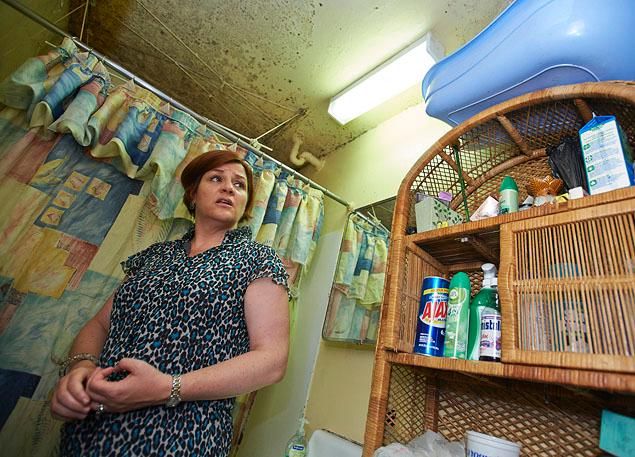
Liu Sued over Shelter Contracts | NYCHA Sleepover | Mapping the Sequester’s Housing Impact

Christine Quinn examines mold while participating in Rev. Al Sharpton’s NYCHA sleepover for mayoral candidates (JAMES KEIVOM)
- Revised plan for taller Midtown fails to assuage critics. “The Bloomberg administration has moved methodically over the past decade to permit high-rise development in once low-scale, industrial neighborhoods from the Far West Side of Manhattan to Williamsburg, Brooklyn.But the administration is now moving to rezone a 70-block area around Grand Central Terminal in densely packed Midtown for even taller skyscrapers, an initiative that it says is necessary in order for the district to retain its allure as a premier office district.”
- Bloomberg sues Liu for rejecting city contracts for homeless shelters. “Fed up with what he views as a pattern of obstructionist behavior, Mayor Michael R. Bloomberg has taken the rare step of filing a lawsuit against the city comptroller, John C. Liu, for rejecting two municipal contracts.The contracts would pay Aguila Inc.,a company run by Robert V. Hess, Mr. Bloomberg’s former commissioner of homeless services, a total of $67.6 million to operate homeless shelters in the South Bronx and on the Upper West Side. The shelters on the Upper West Side, on West 95th Street, have long been a target of criticism from local residents and elected officials, who say, among other complaints, that the area has an excess of similar facilities.”
- Redevelopment efforts to keep Atlantic City grand for tourists pushes poor to outskirts. “As Sandra Taliaferro prepares to move out of her apartment to make way for redevelopment efforts near Atlantic City’s newest casino, she recalls the state of the city when she moved there as a teenager more than 50 years ago.’ You weren’t allowed to go across Atlantic past a certain time,’ said Taliaferro, who is black, explaining that the city remained partly racially segregated.Modern redevelopment efforts are having a similar effect, she said. ‘Now it’s not race; it’s money. You’ve got your side, and I’ve got my side of town.’ ”
- With home prices soaring, has success spoiled San Francisco? “With San Francisco drawing both employees and tech companies from Silicon Valley, houses have become an unaffordable luxury for people in the middle class and even the very highly paid. It’s changing a city historically known as friendly to outsiders wanting to pursue alternative lifestyles. That’s harder to do in an environment where brokers speak blithely of $600,000 and $700,000 ‘starter homes.’”
- Mapping the sequester’s impact on low-income housing. “In April, Doug Rice, senior policy analyst at the Center on Budget and Policy Priorities, released a paper that described some of the ways people would be affected by sequestration cuts to local housing agency budgets, including: up to 140,000 fewer low-income families receiving rental assistance vouchers, higher rent for people who can’t afford it and a rise in homelessness…. A look at over sixty stories from across the country in the past few months reveals that Rice’s analysis was spot-on. Mouse over each location to read the headlines.”
- Housing development plans on a Bushwick vacant lot stirs displacement fears. “Read Property Group’s plan to build 977 rental housing units on the remaining land of the former site of the Rheingold brewery has encountered concerns about rising rents and dwindling park space in Bushwick. As representatives for the company look to address reservations along the way to approval by the City Council, local officials and advocates are making a push to solicit more community input.”
- The rise of the young buyer. “Mr. Winter is part of a growing group of wealthy young buyers who are making inroads in the world of high-end real estate, acquiring properties at prices, and at a pace, that brokers say they have never seen before. Real-estate agents say that young people are buying more expensive homes than previously. They are also more likely to buy several properties, and use one as an investment. Buying real estate has grown more attractive, these young buyers say, compared with the stock market, which appears riskier to a generation that entered the workforce during a market correction.”
- Mayoral candidates attend sleepover in NYCHA’s Lincoln Houses project. “What do you do when a candidate for mayor of New York City is sleeping on your couch?Katherine Wilson, a nurse’s aide who is unemployed, tiptoed around Bill de Blasio, the New York City public advocate, as he lay in her living room in a Harlem housing project on Sunday morning, his 6-foot-5 frames lightly exceeding the length of the couch.”
- Backlog of foreclosures continues to block housing recovery. “While the housing market is on the mend - with progress even in the hardest-hit states - the backlog of homes in foreclosure and real-estate owned properties is still clogging the pipeline, analysts claim. The East Coast is a testament to such findings, where the duration of the foreclosure process is high in large part to judicial foreclosure procedures in states using that process, according to the Federal Reserve Bank of New York’s latest report.”
- In climbing income ladder, location matters. “Stacy’s nearly four-hour round-trip stems largely from the economic geography of Atlanta, which is one of America’s most affluent metropolitan areas yet also one of the most physically divided by income. The low-income neighborhoods here often stretch for miles, with rows of houses and low-slung apartments, interrupted by the occasional strip mall, and lacking much in the way of good-paying jobs.This geography appears to play a major role in making Atlanta one of the metropolitan areas where it is most difficult for lower-income households to rise into the middle class and beyond, according to a new study that other researchers are calling the most detailed portrait yet of income mobility in the United States.”


